The summer dance festival in Japan revellers won’t want to miss
It’s a Sunday afternoon in August when our train pulls into Tokushima City on the east coast of Japan’s fourth largest island, Shikoku.
As we exit the station, it is sweltering, which is typical for Shikoku in August. The dense humidity and searing sun have my clothing drenched by the time I’ve walked a mere 50 metres. But the conditions have not deterred the hundreds of thousands of other people who have descended this day on the pretty, eponymous capital of Tokushima Prefecture on the western shore of the Kii Channel.
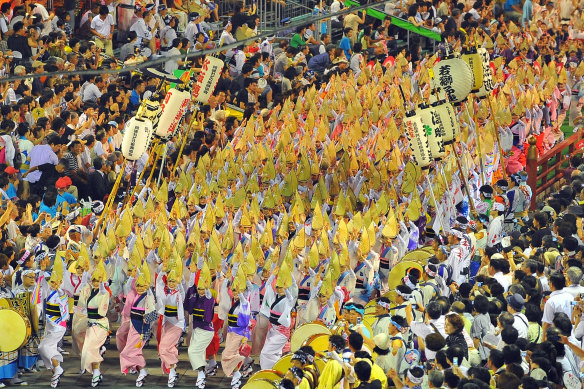
Shikoku’s Awa Odori festival has a carnival-like atmosphere.Credit: Getty
Least deterred, it seems to me, is the remarkable young woman we have stopped to watch play the heck out of a taiko drum. She has beauty, grace, talent, and unbelievable strength and endurance. I think to myself, if Prince were alive and present, he’d be recruiting her for his stage show.
But she’s got her own band, so Prince might have been out of luck.
She is part of a ren, the name given to the many groups of musicians and dancers in town to take part in Tokushima’s famous Awa Odori dance festival. It’s these dancers and musicians that we have gathered to see on the last day of the four-day festival.
The rens are performing one after another on a shaded stage outside a shopping mall in the fading afternoon light. Revellers mill about, drinking beers, taking video, enjoying the chance to see performers before the main event in a few hours’ time.
Awa is the old feudal administration name for Tokushima Prefecture, and odori is the Japanese word for dance.
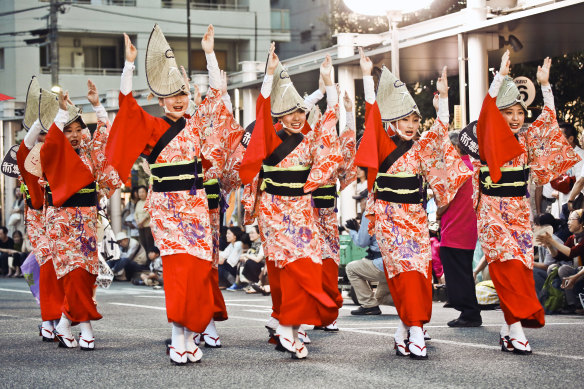
Dancing in the street in a festival of colour. Credit: iStock
There are various stories about how the festival started, but the one thing everyone agrees on is it started a long time ago. One legend has it as beginning as a sake-fuelled celebration of the opening of Tokushima Castle in the 16th century.
A more sensible theory says it grew out of the tradition of dance during Obon, the Buddhist three-day holiday over which the spirits of deceased ancestors are said to visit their living family.
Awa Odori is timed to coincide with it, and it is now one of the largest summer festivals in Japan – and there are many. In Shikoku alone, a succession of cities host a summer dance festival but it’s Awa Odori for which an estimated 1.3 million people gather.
The afternoon has a carnival-like atmosphere as food vendors sell all kinds of local fast food and drink along Shinmachibashi Street, the city centre’s main boulevard, and the boardwalk beside the Shinmachi River which crosses it.
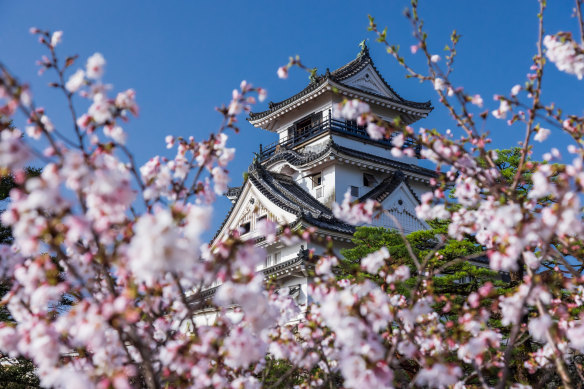
Blossom bounty - Shikoku Island.
Interspersing the upbeat throng, the ren members add exotic colour with their costumes. Each ren comprises members of all ages from workplaces, schools or societies of some sort and each has their own uniform.
But across the board, those who perform the traditionally female dance wear a yukata – a summer-weight kimono, and an amigasa, a woven grass hat shaped like an upside-down cocked hat. It’s worn at a precarious tilt to the front. Speaking of precarious, on their feet they wear geta, wooden thong sandals elevated by two blocks. The traditionally male dance is done in a much more comfortable happi coat, shorts and flat footwear.
As the sun begins to sink behind the rise that overlooks the city, Mount Bizan, and the yellow and red lanterns strung along the streets start to glow, the bleachers lining Shinmachibashi St fill up. Other spectators find a viewing spot where they can. And the ren gather at their starting point.
Soon, they snake past the crowds.
Men and women do a variation of the same simple dance and chant as their musicians play the same tune on a combination of the shamisen lute, taiko drum, shinobue flute and the kane, a kind of bell.
But the drama and spectacle is in the volume of them. About 100,000 dancers take part in the parade, some showing polish and expertise, others in it with less serious dedication to choreography, their good-intentioned clumsiness all part of the show.
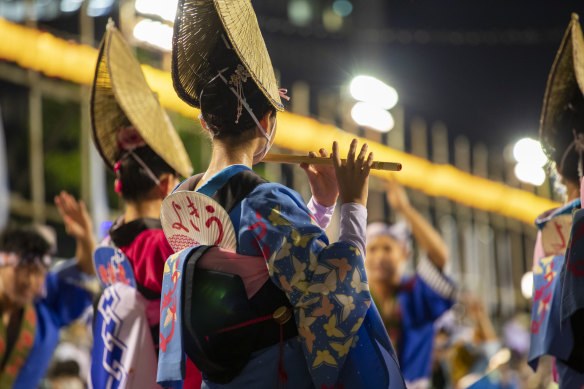
Colour, movement and exquisite costumes.
Some of the larger, more polished ren also include a yakko odori, or kite dance, involving a bracket of acrobatics and interpretive dance by male performers.
It’s quite simply a thing of joy, all smiles and cheers and fun, but I pause to think, no wonder so many women have opted to dance the male component in those comfy flat shoes. Not only is the women’s dance done in geta, but they do the steps balancing on the front platform and toe of the sole, as if on an invisible high heel.
Finally, at the rear of the ren, uncostumed revellers are invited to join in, a huge chaotic procession of glee and giggling as the uninitiated attempt coordination after a day of heat and in many cases, alcohol. It’s a response to the call of the chant the rens perform which translates basically as “the dancers are fools, the watchers are fools, both are fools alike, so why not dance?”
After the parade, the streets stay lively until well into the wee hours. After all, Awa Odori, and its chance to be foolish, comes once a year.
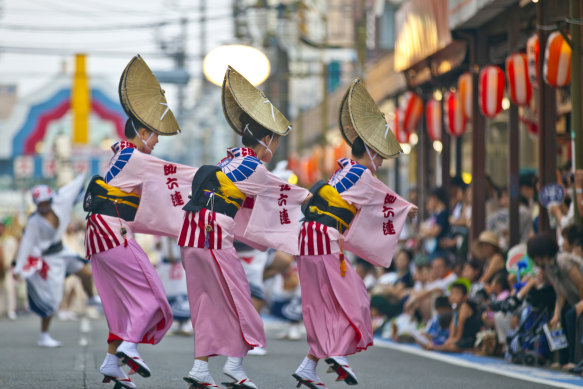
Women in traditional costume perform Awa Odori dance.Credit: iStock
THE DETAILS
FLY
Qantas flies direct to Tokyo from both Sydney and Melbourne. From there, JAL flies domestically to Tokushima. See qantas.com ; jal.co.jp
EXPERIENCE
Awa Odori is held every year in mid-August. If you’re visiting Tokushima outside Awa Odori time you can experience some of the flavour and fun of the event at Awa Odori Kaikan, a museum, where there are regular performances of the dance.
OTHER OBON SEASON FESTIVALS
Kochi City hosts the Yosakoi Festival in August, featuring hundreds of dancing teams. It’s one of Japan’s 10 largest festivals.
The Sanuki Takamatsu Festival is held in Takamatsu Central Park in August, also featuring dancer parades and entertainment.
The writer travelled as a guest of the Japanese National Tourism Organization. See japan.travel
Sign up for the Traveller Deals newsletter
Get exclusive travel deals delivered straight to your inbox. Sign up now.